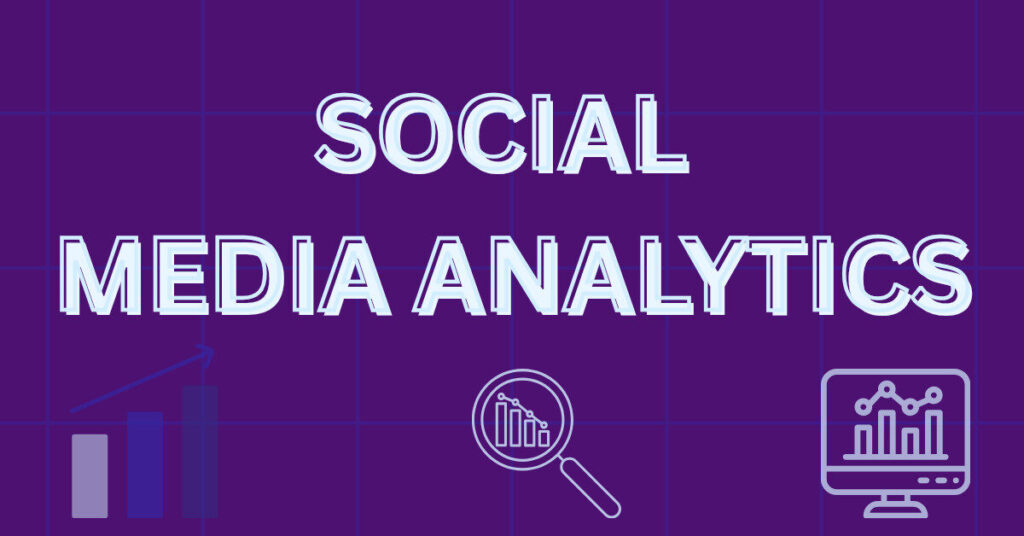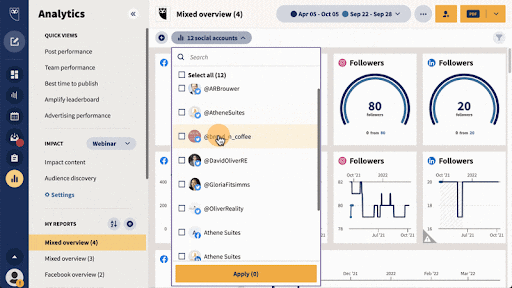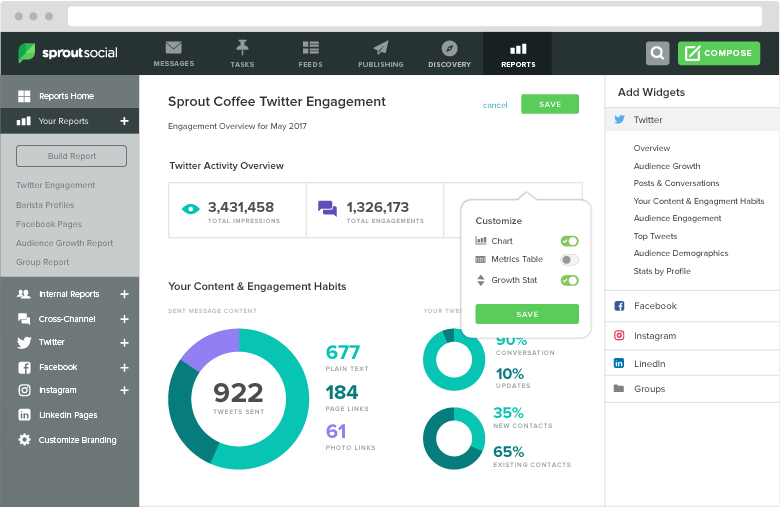
In today’s digital age, social media has become a powerful tool for brands to reach their target audience. However, just posting content isn’t enough. To truly make an impact, you must understand what’s working, what’s not, and why. This is where social media analytics should be considered. It plays a crucial role in shaping a brand’s strategy and ensuring growth through data-driven decisions.
Overview Of What Social Media Analytics Is

Social media analytics refers to the process of collecting, analyzing, and interpreting data from social media platforms to guide decision-making. This includes tracking metrics such as likes, shares, comments, click-through rates, impressions, and audience growth.
See it as a feedback system. Whenever you post on Instagram, Twitter (X), LinkedIn, or Facebook, you receive feedback in the form of data. Social media analytics helps you understand things like:
- The type of content your audience prefers
- The suitable times to post
- The platforms that bring the most engagement
- The strategies that are working and the ones that are not
Social media analytics can help identify which products are in demand, what content format (video, infographic, text) gets the best results, and how to better serve your target audience.
The Major Components Of Social Media Analytics

To make the most of social media analytics, it’s important to understand its core components. These elements help brands make sense of the data they collect and use it to improve their social media strategy.
Here are the key elements you need to know:
1. Audience Analytics
This shows who is engaging with your content. It highlights their age, gender, location, interests, and online behaviors. Understanding your audience helps you to create content that meets their needs.
2. Engagement Analytics
Engagement refers to likes, shares, comments, retweets, mentions, and other ways users interact with your posts. High engagement usually means your content is resonating well with your followers. Low engagement, on the other hand, may suggest the need to change your approach or messaging.
3. Reach and Impressions
- Reach is the total number of unique users who saw your content.
- Impressions count is a measure of how many times your content was displayed.
These metrics help you measure brand visibility. Understanding this, helps you figure out if your content is getting enough exposure or if it’s just floating under the radar.
4. Traffic Analytics
If your social media posts include links to your website or blog, traffic analytics can show how many users clicked through. This is crucial for brands promoting online courses, downloadable resources or selling products via their websites.
5. Sentiment Analysis
This evaluates whether the conversation around your brand is positive, negative, or neutral. It helps in understanding your brand reputation online.
By monitoring all these components, every brand can make informed decisions that drive growth and engagement.
Examples Of Social Media Analytics Tools
There are numerous tools available that make social media analytics easier and more insightful. These are some popular ones to consider:
1. Google Analytics
While primarily used for websites, it can be integrated with social media platforms to track traffic and conversions from social sources.
While not solely a social media tool, it can be incredibly useful when tracking how traffic from social media contributes to your website’s performance. It shows how many people visit your site from social media platforms, how long they stay, and whether they convert into leads or customers. This helps in measuring the real value of your social media campaigns.
2. Hootsuite

A comprehensive tool that offers scheduling, monitoring, and reporting for multiple platforms.
It allows you to manage multiple social media platforms in one place and provides detailed reports on engagement, reach, and more. You can also schedule posts and monitor conversations around your brand, making it easier to stay on top of your strategy.
3. Sprout Social

Another all-in-one platform offering in-depth analytics and reporting.
Sprout Social offers in-depth analytics features that help you understand what content works best. It also provides competitive insights, which can help brands see how they compare with others in their industry. The tool also offers a reporting feature that’s ideal for presenting data to stakeholders.
4. Buffer
Buffer is one of the most popular and user-friendly social media management tools available today. It helps businesses, entrepreneurs, and digital brands plan, publish, and analyze content across various social media platforms.
For any brand trying to maintain a consistent online presence and measure results, Buffer offers a powerful suite of features that simplifies day-to-day social media tasks and enhances overall strategy.
Each of these tools helps brands track their performance and adjust strategies based on real data.
Importance Of Social Media Analytics

The importance of social media analytics cannot be overstated, it is very important for any brand that exists. It is the key to understanding whether your efforts are paying off or if you need to change your strategy. Without analytics, brands are essentially flying blind.
These Some Major Reasons Why Social Media Analytics Is Important:
1. Data-Driven Decisions
Social media analytics empowers brands to make data-driven decisions rather than relying on guesswork or intuition.
This means understanding exactly which posts, topics, and formats perform best. Instead of assuming that a motivational quote or coding tip will do well, the brand can analyze engagement metrics to see what truly resonates with its audience. This eliminates wasted efforts and ensures each post contributes toward strategic goals.
2. Improved Engagement
One of the biggest benefits of social media analytics is the ability to boost engagement. By tracking which content types (videos, carousels, infographics, etc.) drive likes, shares, and comments, every brand can tailor its content to match what the audience enjoys. Engagement is more than ordinary metrics, it’s a signal that your content is connecting and providing value. Analytics reveals those moments of connection and helps you create more of them.
3. Greater Return On Investment
For any business that uses social media, return on investment (ROI) is a crucial indicator.
Social media analytics allows brands to track every click, conversion, and interaction to see which efforts are driving revenue or goal completions. It could be sign-ups for a new workshop or purchases of a product. Analytics connects the dots between content and business outcomes
Related Posts
Time and money are valuable. Analytics helps ensure that your efforts are actually paying off, whether in the form of followers, sign-ups, or sales.
4. Comprehension Of The Audience
Knowing your audience is at the heart of any successful social media strategy, and analytics plays a huge role in building that understanding.
Analytics reveals who your audience is and what they want. This is essential for any brand that needs to deliver the right message to the right people.
When you know which types of content work best (videos, carousels, infographics) you can plan your content calendar and posts more effectively.
6. Competitive Advantage
With analytics tools, you can benchmark your performance against competitors, comparing follower growth, engagement rates, and content strategies. This competitive insight shows where you stand in the market and helps identify opportunities to outperform others in your niche.
With this, you can refine your strategy and stay ahead in the game.
Social media analytics doesn’t just tell you what happened, it helps you figure out why it happened and what to do next.
How to Write a Good Social Media Analytics Report

A well-crafted social media analytics report can help your team understand performance and make informed decisions. Creating a solid social media analytics report is essential for tracking progress and communicating results to your team or clients. A well-written report provides a clear picture of what’s happening on your social media platforms and what steps should be taken next.
The most effective way to compose one is as follows:
1. Establish your objectives
Before starting any social media analytics report, the first and most important step is to define your goals. Your report will be aimless and unclear if you don’t have clear goals. Goals give your analytics purpose and allow you to evaluate whether your social media strategy is truly working.
2. Select the appropriate metrics
Once your goals are defined, the next step in writing a good social media analytics report is to select the right metrics. Metrics are the numbers that tell you how well you’re meeting your goals. They vary depending on the goal itself. If your aim is to raise brand awareness, you might look at reach and impressions. If you’re focused on engagement, then likes, shares, and comments become more important.
3. Collect Data
Now that you know what to measure, it’s time to gather data. Data collection is the backbone of any social media analytics report. This involves pulling numbers from each platform like Facebook, Instagram, LinkedIn, TikTok, or Twitter, depending on where your brand is active. Each platform has its own built-in analytics tools, and you can also use third-party tools like Hootsuite, Sprout Social, or Buffer to consolidate the data.
4. Organize the Report
After collecting your data, the next step is to organise the report in a logical and readable way. A well-structured report is much easier for readers to digest and understand. Begin with a summary or overview of the report’s purpose, the goals you’re measuring, and a snapshot of overall performance. This sets the stage for what’s to come.
Structure your report with clear headings like this :
- Summary
- Important metrics
- Top-performing content
- Audience knowledge
- Suggestions
5. Visualise the Data
Data visualization plays a key role in a strong social media analytics report. Instead of only presenting raw numbers, use charts, graphs, and tables to visualise the data in a way that’s easy to interpret. This makes it possible to see trends, comparisons, and outliers at a glance. For example, a line graph can show follower growth over time, while a pie chart can display audience demographics.
6. Analyze and Interpret
Collecting data and creating visuals is just the beginning. The real value of a social media analytics report comes when you analyse and interpret what the data means. Go beyond the numbers and explain the story they tell. Ask questions like: Why did engagement drop this month? What caused a spike in followers? Which content type performed best?
Don’t just show numbers, explain what they mean.
7. Make Practical Suggestions
Once you’ve interpreted the data, it’s time to make actionable recommendations. This section is where you turn insights into specific next steps. Don’t just say what happened, explain what to do about it. If video content led to more clicks and shares, recommend creating a monthly video series. If engagement dropped on a particular platform, suggest adjusting the posting schedule or trying new content formats.
Always end your report with clear, data-driven suggestions for the next steps.
8. Keep It Simple
Lastly, keep it straight forward. A social media analytics report should be easy to read and understand.
Avoid technical jargon or overly complex language, especially if your audience includes non-marketing professionals. Use plain language to explain what metrics mean and why they matter. This ensures everyone can follow along and see the impact of your efforts.
A clear and concise social media analytics report ensures everyone on your team knows what’s working and what needs improvement.
For any brand operating in a competitive online space, social media analytics is not just an option, it’s a necessity. It allows you to understand your audience, refine your content, and achieve your business goals more efficiently. By mastering social media analytics, your brand can transition from simply posting content to building a strategic presence that truly delivers results.
It doesn’t matter if you’re just starting out or looking to level up your strategy, make analytics a central part of your planning process. With the right tools and insights, your social media can go from a guessing game to a powerful growth engine.
Tags: How to write a social media analytics report Importance of social media analytics Social media analytics








